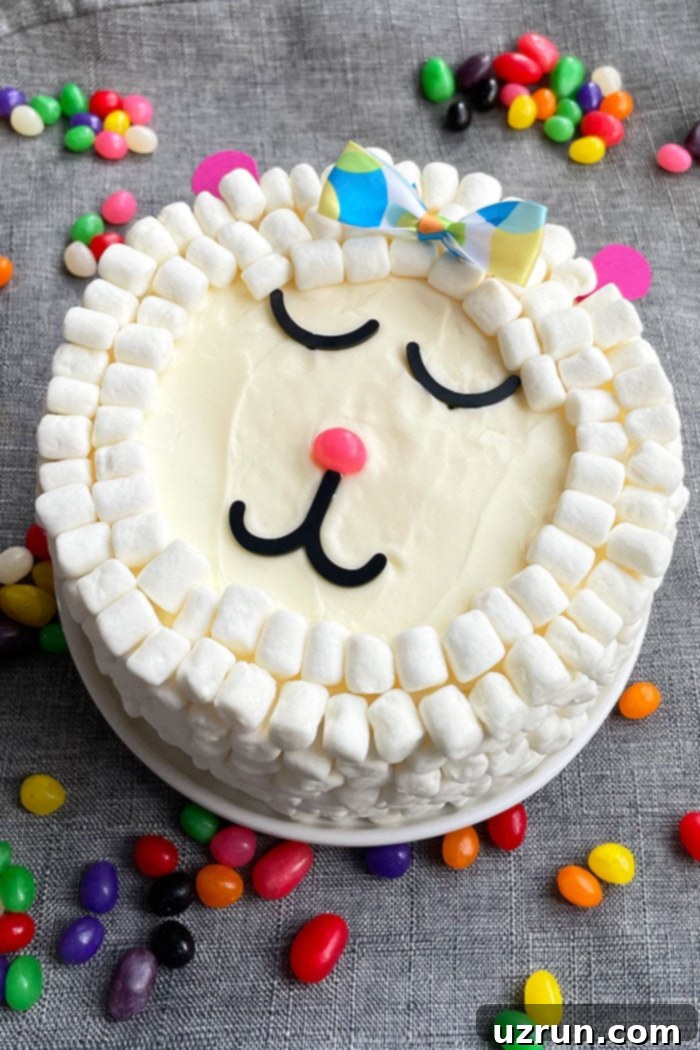Easy & Adorable Easter Lamb Cake Without a Mold: A Step-by-Step Guide
Embrace the spirit of Easter with a delightful and easy-to-make lamb cake, crafted right in your own kitchen without the need for a specialized mold. This charming homemade dessert, covered in fluffy white buttercream icing and textured with mini marshmallows, is a perfect tradition to start with your family. It’s a sweet reminder of the true meaning of Easter, bringing joy and a touch of whimsy to your holiday table. Forget expensive or hard-to-find pans – simply use the round cake pans you likely already have to create this impressive, yet simple, Easter centerpiece.
Beyond this adorable lamb cake, you can explore other creative Easter dessert ideas to complement your celebration. Check out these fantastic options:
- Easter Bunny Cake Topper
- Easter Egg Cake
- More Easter Cake Ideas
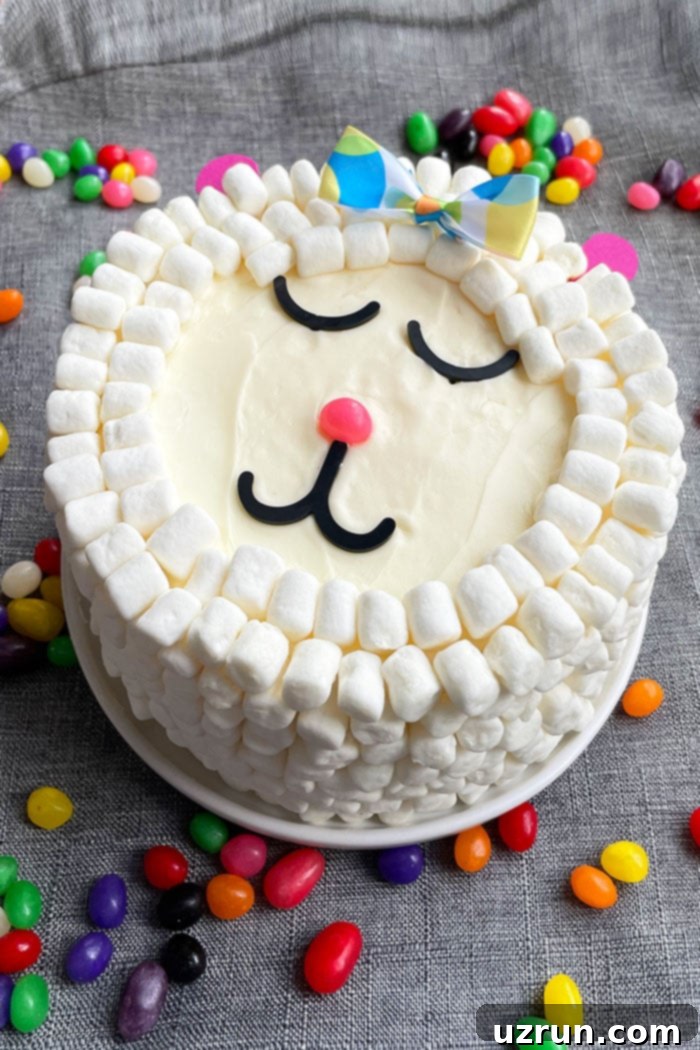
Table of Contents
- What Does the Lamb Cake Symbolize? (Origin & Tradition)
- How to Make an Easy Lamb Cake Without a Mold?
- Creative Variations for Your Vintage Lamb Cake with Marshmallows
- Expert Tips and Techniques for a Perfect Lamb Cake
- Storage Instructions for Your Lamb Cake
- More Festive Easter Desserts
What Does the Lamb Cake Symbolize? (Origin & Tradition)
The tradition of baking a lamb-shaped cake for Easter is deeply rooted in religious and cultural history, primarily symbolizing Jesus Christ as “The Lamb of God.” In the Old Testament, pure, unblemished male lambs were sacrificed as burnt offerings to the Lord, representing atonement and purity. With the advent of Jesus Christ, His sacrifice on the cross at Calvary became the ultimate and perfect offering, fulfilling the ancient prophecies. He is often referred to as “the sacrificial lamb” or “The Lamb of God” because His death atoned for the sins of humanity, offering salvation and new life. This powerful imagery makes the lamb a central figure in Christian theology, especially during Easter, which celebrates His resurrection.
Across Europe, particularly in Germany, the tradition of baking a lamb cake (Osterlamm) became a popular way to commemorate this profound symbolism without consuming meat during the holy season. This practice highlights the lamb’s purity and innocence. As European immigrants, especially those from Germany, settled in America – notably in areas like Chicago – they brought this cherished custom with them. Today, the Easter lamb cake continues to be a beloved tradition, not only in its religious context but also as a charming sign of spring, renewal, and the festive gathering of family and friends. It serves as a beautiful, edible centerpiece that reminds everyone of the deeper meaning behind the Easter celebration.
How to Make an Easy Lamb Cake Without a Mold?
Creating this adorable lamb cake is much simpler than you might think, and it doesn’t require any special molds or advanced decorating skills. By following these straightforward steps, you’ll have a charming and delicious Easter dessert ready to impress.
- Prepare and Cool Your Cakes: Start by baking two round cakes of your chosen flavor. The original recipe suggests 8×2 inch carrot cakes, but any sturdy cake recipe will do. The most crucial step here is to allow your cakes to cool completely to room temperature. Attempting to frost a warm cake will lead to melting frosting and a messy result.
- Whip Up Your Frosting: While your cakes are baking and cooling, prepare both white and black frosting. White buttercream is essential for the lamb’s body, giving it a pure, fluffy appearance. A small amount of black icing will be used for the facial features. Ensure your frosting has a good piping consistency for precise details.
- Assemble and Crumb Coat the Cakes: Place one cooled cake on your chosen serving platter. Spread a generous layer of white frosting evenly over the top of this first cake. Carefully place the second cake directly on top, pressing gently to secure it. Once stacked, apply a thin “crumb coat” of white frosting all over the entire cake. This traps any loose crumbs, ensuring a smooth finish for your final layer. Chill the cake briefly to set the crumb coat.
- Apply the Final Icing and Marshmallows: Once the crumb coat is set, apply a thicker, even layer of white frosting over the entire cake, aiming for a smooth finish on top and sides. Immediately after, gently press mini marshmallows along the sides and top edges of the cake. These will stick directly to the fresh frosting, creating the fluffy “wool” texture of the lamb. Work quickly before the frosting crusts over.
- Add the Facial Features: Fill a piping bag with your black icing. If you don’t have a piping tip, simply snip a very small corner off the bag to create a fine opening. With a steady hand, pipe two small eyes and a gentle mouth onto the front of the cake, bringing your lamb to life. For those less confident with piping, consider using pre-made edible sugar eyes or small chocolate chips.
- Finish with a Nose and Bow: For the nose, gently press a pink jelly bean into the center of the lamb’s face. To add a charming touch, secure a decorative ribbon bow on top of the lamb’s head using a dab of white icing.
- Insert the Ears: Cut out two small ear shapes from pink cardboard or craft paper. Carefully push the bottom edge of each ear into the sides of the cake’s head. These simple ears provide the finishing touch, transforming your round cake into an instantly recognizable, adorable Easter lamb.
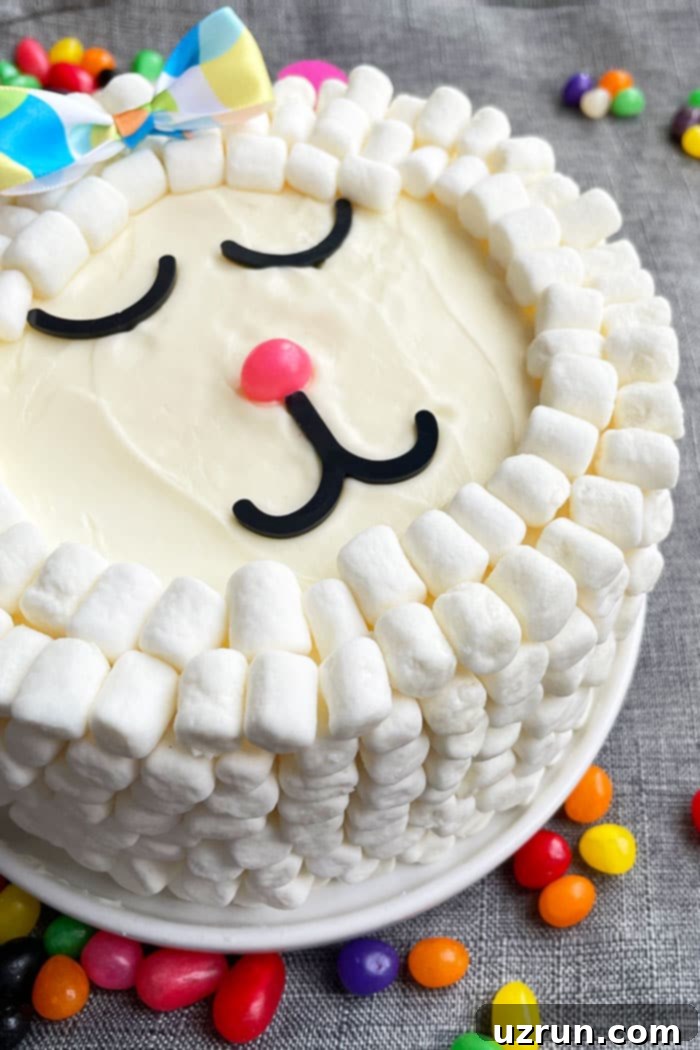
Creative Variations for Your Vintage Lamb Cake with Marshmallows
While the classic white lamb cake with mini marshmallows is undeniably charming, there are many ways to customize this delightful Easter dessert to suit your taste and creativity. Here are some fantastic variations to consider:
- Introduce a Symbolic Filling: To deepen the religious symbolism of the sacrificial lamb, some bakers choose to add a red jelly filling in the center of the cake. This not only adds a burst of fruity flavor but also a poignant visual element. Excellent choices include Strawberry Jam, Raspberry Pie Filling, or Cherry Pie Filling. The vibrant red contrast with the white cake is striking and meaningful.
- Experiment with Different Frostings: While classic White American Buttercream Frosting is a go-to for its smooth texture and easy workability, you can explore other white frostings to vary the flavor and consistency. Consider fluffy Marshmallow Frosting for an extra sweet and airy feel, rich Cream Cheese Frosting for a tangy counterpoint, or decadent White Chocolate Buttercream Frosting for an indulgent twist. For lighter options, Stabilized Whipped Cream can create a delicate cloud-like effect, and Sugar-Free Frosting caters to specific dietary needs.
- Create a “Cupcake Lamb Cake”: If you prefer individual servings or want an even less traditional, mold-free approach, arrange several dozen Vanilla Cupcakes on a large platter. Frost each cupcake with your chosen white frosting, then arrange them in the shape of a lamb. You can still add the piped facial features and marshmallow “wool” to this creative cupcake mosaic, making it a fun and interactive dessert for kids and adults alike.
- Infuse Flavored Extracts: Elevate your cake’s flavor profile by adding different extracts to either the cake batter or the frosting. Brighten things up with lemon extract, add warmth with maple or almond, or give a refreshing twist with peppermint. Butterscotch can offer a rich, sweet depth. These subtle additions can transform the entire dessert experience.
- Explore Diverse Cake Flavors: Don’t limit yourself to one cake flavor! The lamb cake can be made with a variety of delicious bases. Classic vanilla cake is always a crowd-pleaser, but you could also opt for a rich chocolate cake, a decadent Devil’s food cake, a zesty lemon cake, or even an exotic pistachio cake. Choose a flavor that complements the occasion and your guests’ preferences.
- Vary Marshmallow Sizes for Texture: Instead of exclusively using mini marshmallows, try incorporating larger or different-sized marshmallows for a varied texture in the lamb’s “fur.” A mix of sizes can create a more dynamic and interesting visual effect, adding depth to the lamb’s woolly coat.
- Craft a Fondant Bow: If you enjoy cake decorating and have a little extra time, consider making an edible fondant bow instead of a ribbon. This adds another level of homemade charm and means every part of your lamb cake is edible.
- Gender Swap Your Lamb: While a pink ribbon suggests a girl lamb, you can easily “gender swap” your creation. Skip the bow entirely for a more neutral look, or transform it into a cute bow tie for a boy lamb. Use blue or green jelly beans for eyes or nose if desired to further customize.
- Pipe Swirls Instead of Marshmallows: For an alternative to marshmallows, use a star tip and white frosting to pipe small, tight swirls all over the cake. This creates a beautifully textured, wool-like effect that looks incredibly elegant and is another wonderful way to decorate your no-mold lamb cake.
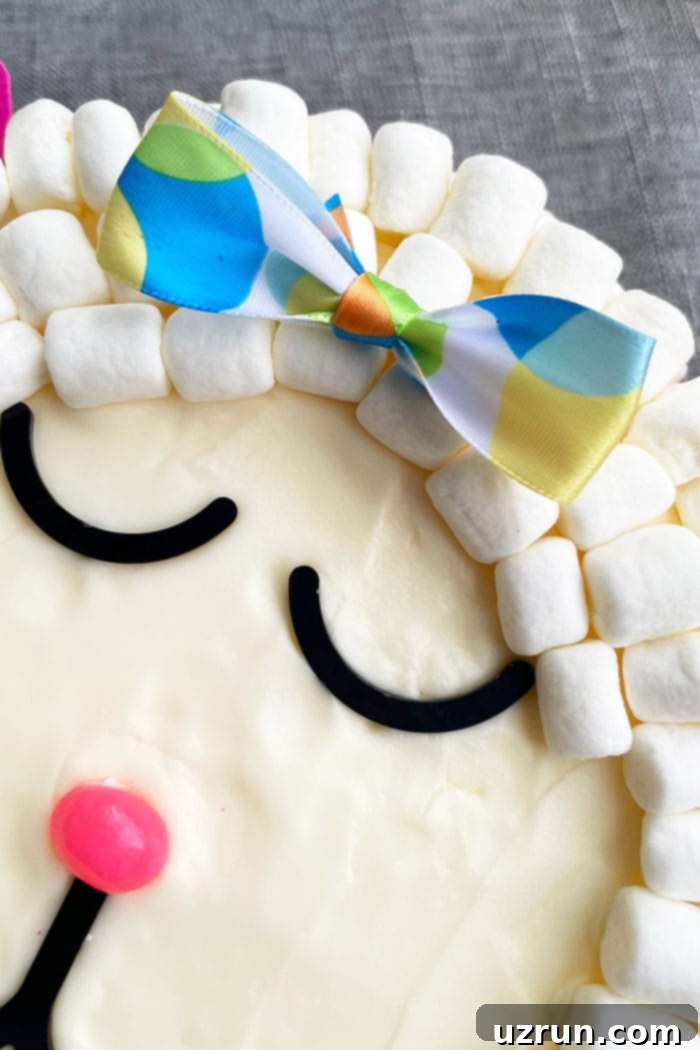
Expert Tips and Techniques for a Perfect Lamb Cake
Achieving a picture-perfect and delicious lamb cake is easier with a few insider tips and techniques. Pay attention to these details, and your homemade creation will be the talk of your Easter gathering.
- Utilize Pre-Made Features for Speed: If piping facial features or shaping a jelly bean nose feels daunting, a fantastic time-saving trick is to use pre-made plastic or edible sugar eyes and mouths. These can be purchased from online cake decorating stores or specialty craft shops. They provide a quick, easy, and often professional-looking finish, allowing you to focus on the rest of the decoration.
- Ensure Your Cake is Completely Cool Before Decorating: This cannot be stressed enough! A warm or even slightly warm cake is the arch-nemesis of smooth frosting. The heat from the cake will melt your beautifully prepared buttercream, causing it to slide off, create unsightly lumps, and turn your decorating efforts into a sticky mess. Always ensure your cakes are cooled completely to room temperature, or even slightly chilled, before you begin frosting. This allows the frosting to set properly and adhere beautifully.
- Stick Marshmallows Immediately After Frosting: The secret to getting your mini marshmallows to adhere perfectly and create that lovely woolly texture is to apply them while the frosting is still wet and tacky. The fresh frosting acts as a natural adhesive. If you wait too long and the frosting begins to dry and form a light crust, the marshmallows won’t stick, and you’ll find yourself struggling to keep them in place. Work in sections if needed, but apply those marshmallows promptly!
- Maximize Your Time with Smart Prep: Easter can be a busy time, so smart preparation is key. While your cakes are baking and cooling, use this downtime to prepare your frostings – whip up the white buttercream and tint a small portion black. Also, gather all your decorating ingredients, such as marshmallows, jelly beans, ribbon, and cardboard for ears. Having everything ready and organized before you start decorating will make the process much smoother and more enjoyable.
- Fondant Ears vs. Cardboard/Paper Ears: The choice between fondant ears and cardboard/paper ears depends largely on your available time and desired aesthetic.
- Fondant Ears: If you’re aiming for a fully edible cake and have extra time, fondant ears are a great option. Roll out pink fondant, cut out ear shapes, and allow them to dry for several hours (or even overnight) until they become firm and hold their shape. This gives a more polished and integrated look.
- Cardboard or Craft Paper Ears: For a quick and convenient solution, firm paper or cardboard ears are perfectly acceptable and widely used. Simply cut out your ear shapes from pink craft paper or thin cardboard, and they’re ready to be inserted. This method saves a lot of time and is perfect for busy bakers. Ensure they are clean and food-safe if they will be directly touching the cake.
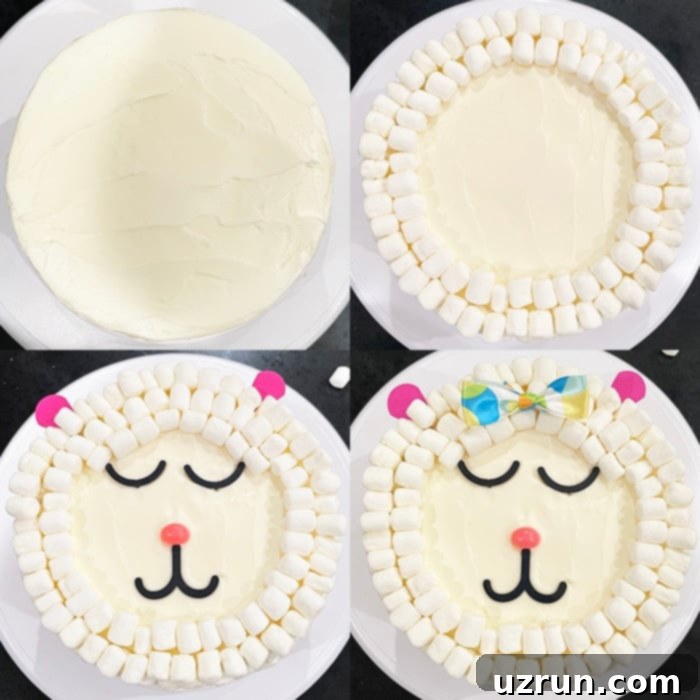
Storage Instructions for Your Lamb Cake
To ensure your beautiful and delicious lamb cake stays fresh for as long as possible, follow these simple storage guidelines:
- Refrigerator: Any leftover lamb cake can be stored in an airtight container in the refrigerator for up to 3 days. Ensure it’s well-sealed to prevent it from drying out or absorbing other odors from the fridge.
- Freezer: If you’re planning ahead or have a lot of leftovers, unfrosted cakes and frostings can be stored separately in sealed containers in the freezer for up to 1 month. When you’re ready to decorate or enjoy, simply thaw the cake and frosting in the refrigerator overnight. Once thawed, you can assemble and decorate as per the instructions above, or enjoy the cake as is. This is a great way to spread out your baking process!
More Festive Easter Desserts
Looking for more sweet inspiration to complete your Easter feast? Explore these other delightful dessert recipes perfect for the spring season:
- Pinata Robin Egg Cake
- Peeps Cake
- Birds Nest Cookies (Easter Chocolate Nest)
- Easter Chick Cupcakes
- Church Window Cookies
- Peanut Butter Eggs
Recipe
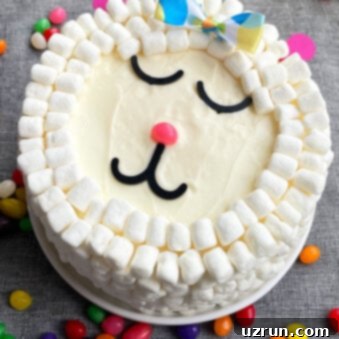
Easy Easter Lamb Cake
Abeer Rizvi
Pin Recipe
Want to Save This Recipe?
Enter your email & I’ll send it to your inbox. Plus, get great new recipes from me every week!
By submitting this form, you consent to receive emails from CakeWhiz
Ingredients
- 2 Round Cakes e.g., Carrot Cake, 8×2 inches each
- 3-4 cups White American Buttercream Frosting
- 1 bag Mini Marshmallows 10 oz. bag
- ⅓ cup Black Frosting
- 1 Pink Jelly Bean
- Ribbon Bow (for decoration)
- Pink Cardboard or Craft Paper (for ears)
Instructions
-
Bake your chosen cakes and allow them to cool completely to room temperature. This is crucial for successful frosting.
-
While the cakes are baking and cooling, prepare both the white and black frostings, ensuring the white buttercream is smooth and the black is ready for piping details.
-
Place one cooled cake on your desired serving dish or cake stand.
-
Using an offset spatula, spread a generous layer of white frosting evenly over the top of the first cake.
-
Carefully place the second cooled cake on top of the frosting layer and press gently to secure.
-
Apply a thin “crumb coat” of white icing smoothly over the entire stacked cake. Chill briefly (10-15 minutes) to set, then apply the final, smooth layer of white icing, covering the whole cake.
-
Immediately after applying the final frosting layer, stick mini marshmallows along the entire sides of the cake and a bit along the top edges, creating the lamb’s wool texture.
-
Fill a piping bag with black icing and snip a very small corner with scissors to create a fine opening for details.
-
With a steady hand, pipe two eyes and a mouth onto the front of the cake using the black icing. Alternatively, use pre-made plastic or edible sugar eyes and mouth features for ease.
-
Gently press a pink jelly bean into the center of the lamb’s face to create a cute nose.
-
Secure a decorative ribbon bow on top of the lamb’s head using a small dab of white icing to hold it in place.
-
Cut two small ear shapes from pink cardboard or craft paper. Carefully push the bottom edge of each ear into the top sides of the cake. Your adorable lamb cake is now complete! Enjoy this festive Easter treat.
Notes
- For best results, make sure to read all the detailed tips and techniques provided above before you begin decorating.
- Leftover lamb cake can be stored in a sealed container in the fridge for up to 3 days.
Nutrition
Carbohydrates: 117g
Protein: 4g
Fat: 14g
Saturated Fat: 3g
Polyunsaturated Fat: 6g
Monounsaturated Fat: 4g
Cholesterol: 68mg
Sodium: 521mg
Potassium: 93mg
Fiber: 1g
Sugar: 90g
Vitamin A: 103IU
Calcium: 50mg
Iron: 2mg
An automated tool is used to calculate the nutritional information. As such, I cannot guarantee the accuracy of the nutritional information provided for any recipe on this site.
